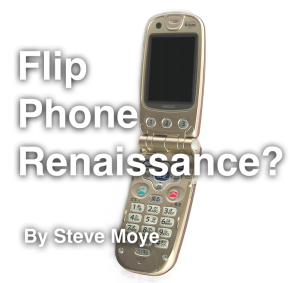 Smartphones, as revolutionary as they are, have been losing their luster. Don’t believe me? Apple, a company whose business is now almost entirely centered on the smartphone, has been having a record-breakingly bad year. Of course, these are still small numbers, so the end isn’t that near for Apple, but the market is clearly looking for the next big thing. Could it be the flip phone?
Smartphones, as revolutionary as they are, have been losing their luster. Don’t believe me? Apple, a company whose business is now almost entirely centered on the smartphone, has been having a record-breakingly bad year. Of course, these are still small numbers, so the end isn’t that near for Apple, but the market is clearly looking for the next big thing. Could it be the flip phone?
For all of its flaws, there was plenty to love about the flip phone, with phones being a rather fluid business: Palm and BlackBerry took the market from Motorola, Apple took the market from Palm and BlackBerry, then faced the Google juggernaut. While Microsoft was always viewed as invincible, the smartphone revolution proved otherwise. I found an article that discussed what it would take to revive the flip phone.
Apple “flipped” the phone market most dramatically after copying a design of a poorly-selling smartphone from LG, the “LG Prada”. The issue with these products is that they were expensive and hard to use. Designs like Palm and BlackBerry worked better simply because they were more useful, with keyboards that made them better for email. Yet everybody missed that phones were more personal devices than work machines, and Apple’s iPhone was simply better-looking and more fun to use while also doing most of what Palm or BlackBerry already did. Yet with Apple pivoting to more of a focus on business to expand its market, there’s a growing opportunity to flip the market back again.
Flip phones, archaic as they seem, do have advantages over the typical smartphone: they were smaller, more portable, easier to balance on your shoulder when talking hands-free, more robust and with a better battery life. It might not have done everything that a smartphone did, but it also cost less, so replacing a lost or broken one wasn’t as big a deal. Yet they weren’t perfect: texting was more tedious than with smartphones, browsing ranged between painful and nonexistent, and there weren’t any apps.
The author of the article argues that, to challenge the iPhone, you’d need to build it so it did a few things, namely tethering and playing music, really well. Most of us have phones in addition to tablets, which more or less do the same thing but are just bigger. Yet if you had your phone mostly do just the core communications transport but left the Web browsing, app running and video playing to tablets and laptops, then you could be more connected with all of your devices without any of them overlapping too much. There could also be device alerting, where when any paired device gets out of range you’d know. Yet the key would be to not just make tethering easier, but also make the transition between phone, tablet and computer easier.
The market seems to be waiting for what comes after the iPhone, and this opportunity is waiting for the next Apple to make that gamble. It doesn’t have to be completely different from how Apple does it, but more than anything else it will require a combination of the functionality of a tablet or PC, the mobility and connectivity of a modern smartphone and the voice capability of Echo. Apple or Microsoft could be the ones to take up the mantle, but maybe a new company could emerge and completely change the game.
